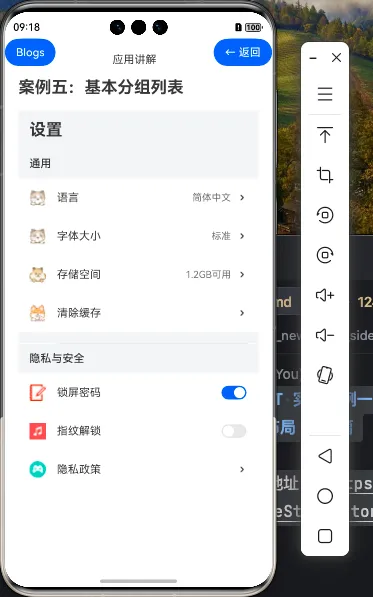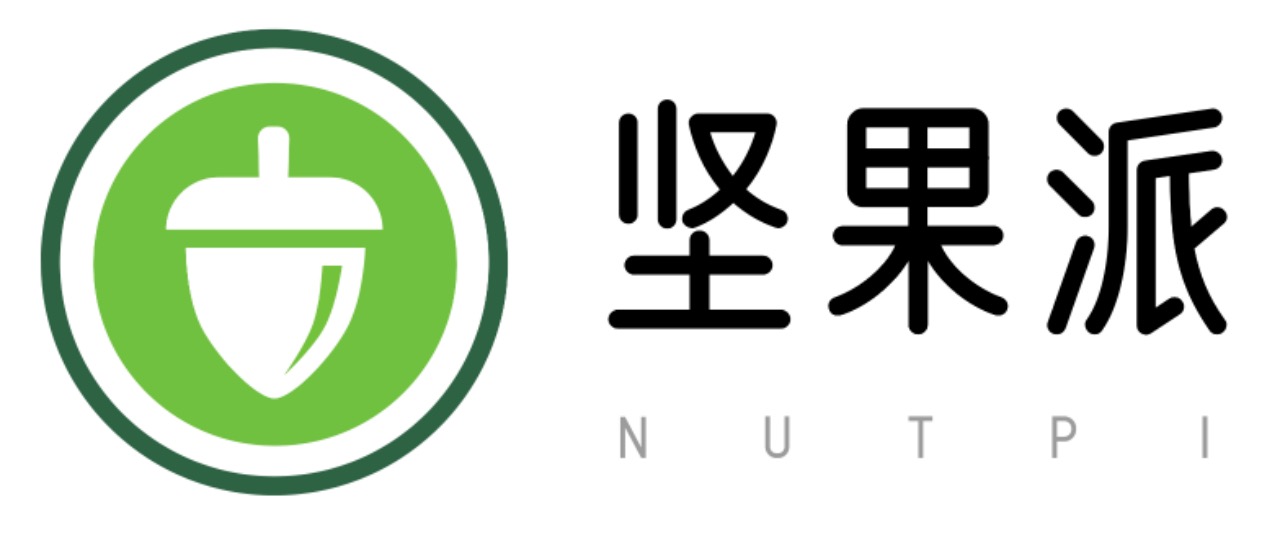142.[HarmonyOS NEXT 实战案例九:List系列] 分组列表组件实战:打造分类设置菜单 进阶篇
2025-06-30 22:17:48
230次阅读
0个评论
[HarmonyOS NEXT 实战案例九:List系列] 分组列表组件实战:打造分类设置菜单 进阶篇
项目已开源,开源地址: https://gitcode.com/nutpi/HarmonyosNextCaseStudyTutorial , 欢迎fork & star
效果演示

一、ListItemGroup组件进阶特性
在基础篇中,我们已经学习了如何创建基本的分组设置菜单。在本篇教程中,我们将深入探讨ListItemGroup组件的进阶特性,包括交互功能、样式定制和状态管理等方面。
1.1 ListItemGroup进阶属性
| 属性 | 类型 | 说明 |
|---|---|---|
| sticky | boolean | 设置分组头部是否吸顶 |
| initialIndex | number | 设置初始展示的组索引 |
| divider | { strokeWidth?: number, color?: ResourceColor, startMargin?: number, endMargin?: number } |
设置分组内列表项之间的分割线样式 |
| header | @Builder | 自定义分组头部内容 |
| footer | @Builder | 自定义分组尾部内容 |
1.2 ListItemGroup与List组件的事件联动
ListItemGroup可以与List组件的多种事件结合使用,实现更丰富的交互效果:
| 事件 | 说明 |
|---|---|
| onScrollIndex | 监听列表滚动时的索引变化,可用于更新当前分组索引 |
| onGroupCollapse | 监听分组折叠事件(需自行实现折叠逻辑) |
| onGroupExpand | 监听分组展开事件(需自行实现展开逻辑) |
二、设置菜单的交互增强
2.1 添加分组折叠展开功能
我们可以为设置菜单添加分组折叠展开功能,让用户可以根据需要展开或折叠某个分组:
@State expandedGroups: Set<string> = new Set(['通用', '隐私与安全', '关于']) // 初始全部展开
// 切换分组展开状态
private toggleGroup(groupName: string) {
if (this.expandedGroups.has(groupName)) {
this.expandedGroups.delete(groupName)
} else {
this.expandedGroups.add(groupName)
}
}
// 构建可折叠的分组头部
@Builder
CollapsibleGroupHeader(groupName: string) {
Row() {
Text(groupName)
.fontSize(16)
.fontWeight(FontWeight.Medium)
.layoutWeight(1)
// 展开/折叠图标
Image(this.expandedGroups.has(groupName) ? $r('app.media.arrow_down') : $r('app.media.arrow_right'))
.width(16)
.height(16)
}
.width('100%')
.backgroundColor('#F1F3F5')
.padding({ left: 16, right: 16, top: 12, bottom: 12 })
.onClick(() => this.toggleGroup(groupName))
}
然后在List中使用这个可折叠的头部:
List() {
ForEach(this.settingsData, (group:SettingType) => {
ListItemGroup({
header: this.CollapsibleGroupHeader(group.groupName),
footer: this.GroupFooter()
}) {
if (this.expandedGroups.has(group.groupName)) {
ForEach(group.items, (item:ItemsType) => {
// 列表项内容(同基础篇)
})
}
}
})
}
2.2 添加设置项交互功能
我们可以为设置项添加点击事件和状态变化处理:
// 处理设置项点击
private handleItemClick(item: ItemsType) {
// 根据不同设置项执行不同操作
if (item.title === '清除缓存') {
// 显示清除缓存确认对话框
AlertDialog.show({
title: '清除缓存',
message: '确定要清除所有缓存吗?',
primaryButton: {
value: '取消',
action: () => {}
},
secondaryButton: {
value: '确定',
action: () => {
// 执行清除缓存操作
}
}
})
} else if (item.rightText) {
// 显示选项对话框
// 这里可以根据不同设置项显示不同的对话框
}
}
// 处理开关状态变化
private handleToggleChange(item: ItemsType, isOn: boolean) {
// 更新开关状态
item.toggle = isOn
// 根据不同设置项执行不同操作
if (item.title === '锁屏密码') {
// 处理锁屏密码开关变化
} else if (item.title === '指纹解锁') {
// 处理指纹解锁开关变化
}
}
然后在列表项中使用这些处理函数:
ListItem() {
Row() {
// 图标和标题(同基础篇)
// 右侧文本或开关
if (item.rightText) {
Text(item.rightText)
.fontSize(14)
.fontColor('#666666')
.margin({ right: 8 })
}
if (item.toggle !== undefined) {
Toggle({ type: ToggleType.Switch, isOn: item.toggle })
.onChange((isOn: boolean) => {
this.handleToggleChange(item, isOn)
})
} else {
Image($r('app.media.arrowright'))
.width(16)
.height(16)
}
}
.width('100%')
.padding({ left: 16, right: 16, top: 12, bottom: 12 })
}
.height(56)
.onClick(() => {
if (item.toggle === undefined) { // 不是开关类型的才响应点击
this.handleItemClick(item)
}
})
2.3 添加分组吸顶效果
我们可以为ListItemGroup添加sticky属性,实现分组头部吸顶效果:
ListItemGroup({
header: this.CollapsibleGroupHeader(group.groupName),
footer: this.GroupFooter(),
sticky: true // 启用吸顶效果
}) {
// 列表项内容
}
三、样式定制与优化
3.1 自定义分组样式
我们可以为不同的分组设置不同的样式,使界面更加丰富:
// 获取分组样式
private getGroupStyle(groupName: string) {
switch (groupName) {
case '通用':
return {
backgroundColor: '#F1F3F5',
textColor: '#333333',
iconColor: '#007DFF'
}
case '隐私与安全':
return {
backgroundColor: '#F5F1F1',
textColor: '#D81B60',
iconColor: '#D81B60'
}
case '关于':
return {
backgroundColor: '#F1F5F1',
textColor: '#388E3C',
iconColor: '#388E3C'
}
default:
return {
backgroundColor: '#F1F3F5',
textColor: '#333333',
iconColor: '#007DFF'
}
}
}
// 构建自定义样式的分组头部
@Builder
StyledGroupHeader(groupName: string) {
const style = this.getGroupStyle(groupName)
Row() {
// 分组图标
Circle({ width: 24, height: 24 })
.fill(style.iconColor)
.margin({ right: 8 })
Text(groupName)
.fontSize(16)
.fontWeight(FontWeight.Medium)
.fontColor(style.textColor)
}
.width('100%')
.backgroundColor(style.backgroundColor)
.padding({ left: 16, right: 16, top: 12, bottom: 12 })
}
3.2 列表项动画效果
我们可以为列表项添加动画效果,提升用户体验:
ListItem() {
Row() {
// 列表项内容(同上)
}
.width('100%')
.padding({ left: 16, right: 16, top: 12, bottom: 12 })
.borderRadius(8)
.backgroundColor('#FFFFFF')
.animation({
duration: 300,
curve: Curve.EaseOut,
iterations: 1,
playMode: PlayMode.Normal
})
.stateStyles({
pressed: {
.backgroundColor('#F0F0F0')
.scale({ x: 0.98, y: 0.98 })
},
normal: {
.backgroundColor('#FFFFFF')
.scale({ x: 1.0, y: 1.0 })
}
})
}
.height(56)
.margin({ left: 8, right: 8, top: 4, bottom: 4 })
3.3 分组间距与分割线优化
我们可以优化分组之间的间距和分割线,使界面更加美观:
List() {
ForEach(this.settingsData, (group:SettingType, index) => {
ListItemGroup({
header: this.StyledGroupHeader(group.groupName),
footer: this.GroupFooter(),
divider: { // 设置组内分割线
strokeWidth: 1,
color: '#E5E5E5',
startMargin: 56,
endMargin: 16
}
}) {
// 列表项内容
}
// 添加分组间距(最后一个分组不添加)
if (index < this.settingsData.length - 1) {
Divider()
.height(16)
.color('transparent')
}
})
}
.width('100%')
.layoutWeight(1)
.listDirection(Axis.Vertical) // 确保垂直方向
.edgeEffect(EdgeEffect.Spring) // 添加边缘效果
.chainAnimation(true) // 启用链式动画
四、状态管理与数据处理
4.1 设置项状态管理
我们可以使用@State装饰器管理设置项的状态,实现数据的响应式更新:
@State settingsData: SettingType[] = [...] // 初始数据
// 更新设置项值
private updateSettingValue(groupName: string, itemTitle: string, newValue: string | boolean) {
// 查找并更新设置项
const groupIndex = this.settingsData.findIndex(group => group.groupName === groupName)
if (groupIndex >= 0) {
const itemIndex = this.settingsData[groupIndex].items.findIndex(item => item.title === itemTitle)
if (itemIndex >= 0) {
if (typeof newValue === 'string') {
this.settingsData[groupIndex].items[itemIndex].rightText = newValue
} else if (typeof newValue === 'boolean') {
this.settingsData[groupIndex].items[itemIndex].toggle = newValue
}
}
}
}
4.2 添加搜索功能
我们可以为设置菜单添加搜索功能,帮助用户快速找到所需的设置项:
@State searchText: string = ''
@State filteredData: SettingType[] = []
// 过滤设置项
private filterSettings() {
if (!this.searchText) {
this.filteredData = this.settingsData
return
}
// 过滤包含搜索文本的设置项
this.filteredData = this.settingsData.map(group => {
const filteredItems = group.items.filter(item =>
item.title.includes(this.searchText)
)
return filteredItems.length > 0 ?
{ groupName: group.groupName, items: filteredItems } :
null
}).filter(group => group !== null) as SettingType[]
}
然后在页面顶部添加搜索框:
Column() {
// 标题栏
Row() {
Text('设置')
.fontSize(24)
.fontWeight(FontWeight.Bold)
}
.width('100%')
.height(56)
.padding({ left: 16 })
.backgroundColor('#F1F3F5')
// 搜索框
Row() {
Image($r('app.media.search'))
.width(24)
.height(24)
.margin({ right: 8 })
TextInput({ placeholder: '搜索设置项', text: this.searchText })
.layoutWeight(1)
.backgroundColor('transparent')
.onChange((value: string) => {
this.searchText = value
this.filterSettings()
})
if (this.searchText) {
Button() {
Image($r('app.media.clear'))
.width(16)
.height(16)
}
.width(24)
.height(24)
.backgroundColor('transparent')
.onClick(() => {
this.searchText = ''
this.filterSettings()
})
}
}
.width('100%')
.height(48)
.padding({ left: 16, right: 16 })
.backgroundColor('#FFFFFF')
.border({ width: { bottom: 1 }, color: '#E5E5E5' })
// 设置列表(使用filteredData代替settingsData)
// ...
}
4.3 设置项分类与排序
我们可以实现设置项的分类和排序功能,让用户可以自定义设置菜单的显示顺序:
// 设置项排序方式
enum SortOrder {
DEFAULT,
ALPHABETICAL,
CUSTOM
}
@State sortOrder: SortOrder = SortOrder.DEFAULT
@State customOrder: string[] = [] // 自定义排序顺序
// 获取排序后的设置数据
private getSortedSettings(): SettingType[] {
let result = [...this.filteredData]
switch (this.sortOrder) {
case SortOrder.ALPHABETICAL:
// 按字母顺序排序
result.forEach(group => {
group.items.sort((a, b) => a.title.localeCompare(b.title))
})
break
case SortOrder.CUSTOM:
// 按自定义顺序排序
if (this.customOrder.length > 0) {
result.sort((a, b) =>
this.customOrder.indexOf(a.groupName) - this.customOrder.indexOf(b.groupName)
)
}
break
default:
// 默认顺序,不做处理
break
}
return result
}
总结
在本篇教程中,我们深入探讨了HarmonyOS NEXT的ListItemGroup组件的进阶特性和用法。通过这些进阶技巧,我们可以构建更加功能丰富、交互友好的分组设置菜单。这些知识点不仅适用于设置菜单,也可以应用到其他类型的分组列表界面设计中,如商品分类、文件管理等。
00
- 0回答
- 5粉丝
- 0关注
相关话题
- 141.[HarmonyOS NEXT 实战案例九:List系列] 分组列表组件实战:打造分类设置菜单 基础篇
- 134.[HarmonyOS NEXT 实战案例六:List系列] 垂直列表组件实战:打造高效联系人列表 进阶篇
- 138.[HarmonyOS NEXT 实战案例七:List系列] 多列列表组件实战:打造精美应用推荐页 进阶篇
- 152.[HarmonyOS NEXT 实战案例十二:List系列] 卡片样式列表组件实战:打造精美电商应用 进阶篇
- 144.[HarmonyOS NEXT 实战案例十:List系列] 字母索引列表组件实战:打造高效联系人应用 进阶篇
- 140.[HarmonyOS NEXT 实战案例八:List系列] 滑动操作列表组件实战:打造高效待办事项应用 进阶篇
- 148.[HarmonyOS NEXT 实战案例八 :List系列] 粘性头部列表进阶篇
- 156.[HarmonyOS NEXT 实战案例十二 :List系列] 聊天消息列表 - 进阶篇
- 136.[HarmonyOS NEXT 实战案例七:List系列] 水平列表组件实战:打造精美图片库 进阶篇
- 146.[HarmonyOS NEXT 实战案例七 :List系列] 可选择列表进阶篇
- 154.[HarmonyOS NEXT 实战案例十一 :List系列] 自定义内容列表 - 进阶篇
- 150.[HarmonyOS NEXT 实战案例十一:List系列] 下拉刷新和上拉加载更多列表组件实战:打造高效新闻应用 进阶篇
- [HarmonyOS NEXT 实战案例六:List系列] 垂直列表组件实战:打造高效联系人列表 基础篇
- 137.[HarmonyOS NEXT 实战案例七:List系列] 多列列表组件实战:打造精美应用推荐页 基础篇
- 151.[HarmonyOS NEXT 实战案例十二:List系列] 卡片样式列表组件实战:打造精美电商应用 基础篇
